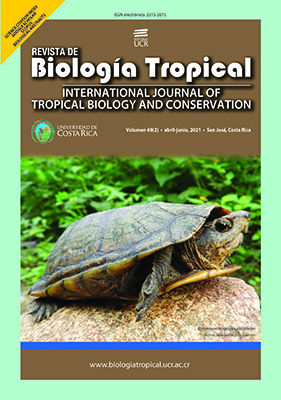Abstract
Introduction: One of the major threats to aquatic ecosystems is the introduction of foreign species in natural environments. This represents one of the main causes of biodiversity loss in the world. P. hypophthalmus is an introduced species in Colombia that shares life characteristics and habitat with native species such as A. pardalis, S. cuspicaudus y P. magdaleniatum. However, its distribution is little known and the effects it has on the native fauna have been little explored. Objectives: To evaluate the P. hypophthalmus invasive potential in some of the basins, which drain into the Caribbean Sea. Methods: Using records available in various databases, we performed a niche conservatism analysis between the native and introduced records of P. hypophthalmus in the Ecospat. Subsequently, we modeled the potential invasion area of this species and the distribution areas of the three native species using the Maxent algorithm. Finally, we calculated a geographic niche overlap between the non-native and native species. Results: The Ecospat spatial analysis indicates that the non-native species show niche conservatism. For this reason, the ENM can be used as an approximation to its range of distribution in the invaded area. The ENM demonstrates that the four species analyzed prefer low and slightly rocky areas; for that reason, the geographical overlap of the ecological niches of the three native species and the introduced species yield values that exceed 80%. Conclusions: There are adequate conditions in the study basins for a full establishment of the species P. hypophthalmus, which represents a high risk for aquatic ecosystems and native ichthyofauna. Knowledge of the potential distribution areas is essential to implement control of the species.
##plugins.facebook.comentarios##

This work is licensed under a Creative Commons Attribution 4.0 International License.
Copyright (c) 2021 María Camila Castellanos-Mejía, Juliana Herrera Pérez, Elkin A Noguera-Urbano, Edison Parra, Luz Fernanda Jiménez-Segura







